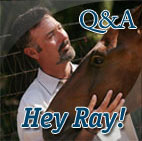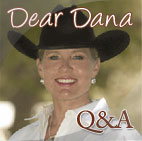Another Choice: High or Low?
Simple adjustments in your bitting make a difference
 Fourth in a series
Fourth in a series
Before entering the arena, we take a closer look at the details of our snaffle bit.
I tend to ride with the snaffle fairly low in the horse’s mouth. Often I’ll have it a half-inch or more off (below) the corners. I find that the lower I have the snaffle the lower a horse’s head will tend to go. Normally we want their heads low since our ultimate goal is to get the horse’s back rounded and his weight distributed to the hindquarters so we can maximize his performance. The one time I might be careful here is if I’m on a horse that has heavy shoulders, because if he carries his head too low it will be hard to keep his weight off of his front end.
Equipment you’ll need: Snaffle Bits
 Third in a series
Third in a series
Before entering the arena, we take a closer look at an important piece: snaffle bits.
Now let’s talk about snaffle bits. Snaffles come in an enormous variety of shapes and forms – fat or skinny, smooth or twisted, straight or curved, heavy rings or light rings, D-rings or O-rings, even inlaid and wrapped! And once you’ve decided on a particular bit, you can still change the response you get from it according to how high or low you place it in your horse’s mouth! So where do you
start?
What are the Five Easy Pieces?
 Second in a series
Second in a series
Here are the ‘Five Easy Pieces’, and Les urges you to commit these five to memory as his column in each Horsetrader will refer to them.
1) Lateral Flexion
Piece number one is getting the horse to yield his nose to the side as a response to you just lightly moving the rein. As you’ll hear and read again and again in this program – the KEY to achieving success in a performance training program is having a horse that will do everything you ask with a soft and resistance-free neck. By staying with this exercise until your horse will respond to a rein that still has some slack in it, I know, and you will too, that he is giving his head and neck willfully and not being forced. Again, you’ll do this exercise both to the right and the left.
Let’s start: Five Easy Pieces
 First In A Series
First In A Series
In the next few installments, Les Vogt takes you through exercises of his Five Easy Pieces. When you’ve mastered them, you should be able to put any part of your horse’s body where you want it, without resistance.
Doesn’t it take your breath away to watch a sensational reining or cow horse perform? It does to me, just like it did back when I was a kid and I saw my first stock horse in action. But the best thing about it is that these horses just keep getting better and better. First, because we’re breeding them better, and second, because we’re riding them better. And the biggest key I have found in developing that brilliant performance is the time that I spend getting complete body control during the foundation stage of my training on a young horse.
Dealing with a Distracted Horse
 Next in a series
Next in a series
After our reviewing of backing, let’s take a look at the key to handling a distracted horse: patience.
Sometimes when you’re riding you’re going to lose your horse’s attention. I say don’t make a big deal out of it. Some might not see as well as others, or may be more spooky, especially as far as young horses go, when they go off to the Bahamas every now and then; leave it alone and it goes away. Be patient.
Backing: More cue than pull
 Next in a series
Next in a series
After last issue’s wrap-up of the importance of hip control, let’s take a detailed look at backing your horse.
Your goal when you back is to not have to pull back hard on the horse’s mouth to get him to move backward, but to be able to use just enough contact with the bit to tell him to not go forward – kind of like shifting him into reverse – and then using your legs, like the gas, to move backward. Yes, you might have to tug a little to get him started, but your goal is to take it from an active rein cue to an active leg cue as quickly as possible.
The importance of hip control
 Next in a series
Next in a series
In the last two issues, we looked at on-the-fence body control with focus on the shoulder and hip, respectively. Here’s a last look at the importance of these practices before we move on.
Having control of the horse’s hips will prove to be quite critical for almost all of your reining maneuvers. You’ll need it for departures, lead changes and turnarounds particularly. Since many of the body control exercises that we’ll be working on in the next level will require you to have some hip control, you need to get started on it early in the program.
Exercise #4: Hip control on the fence
 Next in a series
Next in a series
Our look at on-the-fence body control continues with focus shifting to the hip.
Start by walking along the fence. Pick a point to stop the horse and then make a very light contact with your inside (away from the fence) rein while you reach back with your fence-side leg and push or bump your horse’s hip around. You’re creating energy with your leg to push the hip, and your brace rein contact will lightly block him from pushing through with his shoulder. With the fence in front of him you don’t give your horse any other options but to move his hip. Do this exercise repeatedly (it’s called a turn on the forehand) both directions. Start by just asking for a step at a time and then increase the number of steps as your horse’s responses get more consistent. Remember to keep life in your reins and leg as you ask for this exercise.
 Next in a series
Next in a series
After learning about the brace rein and the benefits of ribcage control last issue, let’s explore side passing.
The Brace Rein
Exercise number three is basically side passing, but it will have one big difference for most of you. While most novice riders start side passing by moving the shoulders and catching up with the hips, I’m not going to let you do it that way. Letting a horse lead with his shoulders creates such a disaster when it comes to lead changes that we simply never let them lead with their shoulders when we use our leg in the middle, or the back, position. We are always using a light brace rein to keep their shoulders out of the way, or at least neutral.
Starting Exercises # 3 & 4
Ribcage & Hip Control on the fence
 Next in a series
Next in a series
After working recently on bending and alignment, let’s take a closer look this issue at the exercises.
The Brace Rein
Remember how you used your rein to move the horse’s shoulders? First making light contact for bend, then lifting your hand and moving over to direct the shoulders?
Well the brace rein is the same concept, except rather than using it to move the horse’s shoulders, you’re just asking him to keep them out of the movement by just maintaining a slight bend with his neck. Whenever you are using the brace rein, you want to make sure that your other rein is way away from the horse’s neck.
 When would we use a brace rein? We’ll use it in exercises three and four, which we’ll start in this lesson, and after that, mainly for lope departures and lead changes. In exercise number four, which is for hip control, when you want to move your horse’s hips to the right, you will use a brace rein to make sure his shoulders stay to the left
When would we use a brace rein? We’ll use it in exercises three and four, which we’ll start in this lesson, and after that, mainly for lope departures and lead changes. In exercise number four, which is for hip control, when you want to move your horse’s hips to the right, you will use a brace rein to make sure his shoulders stay to the left
or at least straight, so that you isolate only the hip with the movement. If you’re not effective at keeping the shoulders out of the way with your brace rein when you use your leg in the back, or hip, position, the energy will most likely come out the shoulders instead.
As we start to move the hips and ribs, learning to keep the shoulders out of the way while keeping life in your hands will take a little practice, but the better you get it here, the easier you’ll get along when we progress to correct lope departures and lead changes.
Ribcage control
Being able to move the horse’s ribcage has a lot of benefits. For one, if you get a little resistance in the horse’s mouth when you ask him to give laterally, you can help create the bend in his body by pushing his ribs over. This can be especially helpful if you’re riding in one hand. Rather than having to bump the horse straight back you can work at softening him by pushing him back and forth between your legs. You can push the ribs out to increase the size of your circles.
Editor’s Note: More with Les is a regular California Horsetrader column. Les Vogt has won more than 15 World Championships, including two wins at the NRCHA Snaffle Bit Futurity. Although Les still rides and occasionally shows, his focus is giving clinics around the world and developing products for the performance horseman. To learn more about Les and to see his clinic schedule, visit www.lesvogt.com
You can read previous More with Les columns at: http://news.horsetrader.com



 Read Columns
Read Columns

